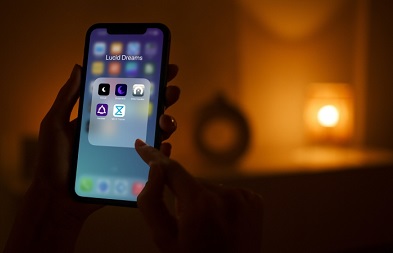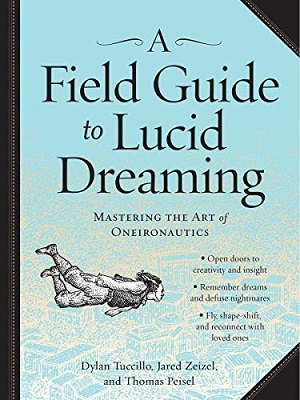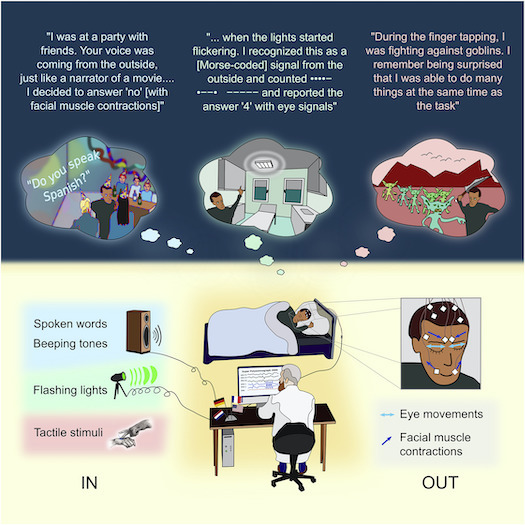Awoken App - A Tool to Help Induce Lucid Dreaming

Awoken is a free app for Android (sorry, not for Apple users yet) that helps people achieve lucid dreaming. It was designed to "combine proven techniques with experimental enhancements made possible by the presence of smartphones."
As has been discussed elsewhere on this web site, lucid dreaming is a state of consciousness that allows a person to be fully in control of themselves and act volitionally during dreams - basically, you know you're dreaming while you're dreaming. It has been scientifically proven that while only a few people naturally experience lucid dreaming on a regular basis, with certain training techniques and help from external queues, people who do not lucid dream can 'learn' to achieve lucid dreaming.
One of the methods used to induce lucid dreaming is to contact the sleeper through the use of sound queues during REM sleep to let them know they are dreaming. Before the sleeper goes to sleep, it is agreed that a certain sound will notify them that they are dreaming. The sleeper is then given the audio queue from an external source while they sleep, which makes the dreamer aware that they are dreaming and thus causes a lucid dreaming state to occur.
Awoken seeks to take these techniques and provide them to regular folks who happen to own a smartphone. When you open Awoken, you are given the tools to make this happen. You can select any sound on your smartphone and set it as the reminder. This is known as the "Totem Sound" in the app. I would suggest making the sound different from any other notification sound on your phone so you know exactly what it's for, and that it isn't used for anything else. You also choose how loud you wish the sound to be played.
Once you have chosen your audio queue, you then tell the app how many times during the day you wish to hear the Totem Sound. This is the 'training' part of the experience - you program the app to notify you with the Totem Sound several times during the day. When you hear the sound, stop what you're doing for a few seconds and check your surroundings. Does everything appear normal? Ask yourself, "Am I dreaming?" and become extra-aware for a few moments.
You then tell Awoken how many times you wish to hear your Totem Sound during the night. These are called "Dream Clues" and it is the same as the Totem Sound except it's at night and you're sleeping when you hear it. If you are dreaming when you hear the Dream Clue, hopefully you do the same thing as when you're awake: ask yourself, "Am I dreaming?" and check your immediate environment for anything that appears unusual. If you discover yourself dreaming, then it worked! Use your imagination and have fun!!!
My experience with the app has been mixed. At first it seemed to have issues with the chosen sound. It sounded as if not one - but two - sounds were happening. This may have been due to the app giving the daytime prompts at the same time as other notifications on my phone (on the hour for example). While this persisted for a few weeks and was annoying, it seemed to clear up after an update.
It also seemed to notify me with my chosen sound more often than I had set it for in the app during the day. This got to be a nuisance and I ended up dialing it back a bit. Again, the issue seemed to stop after an update.
If you don't have a sleeping partner, no worries at all using Awoken. But if you do, another thing users may want to be aware of is that if your sleeping partner is a light sleeper, they may hear your Dream Clues even if you don't. You may be able to resolve this by tweaking the loudness of your Dream Clues.
You can also temporarily "pause" the app at any time which stops all notifications. It also provides a way for you to keep a dream journal. While I have not used the dream journal myself, it looks like a great tool for someone who wants to use it.
While I agree with the basic premise on which the app is built, I have not been able to achieve a lucid state while dreaming as a result of using the app. This may be due to the Dream Clues not happening during REM sleep, or it might be other factors I'm not aware of. But I have not stopped trying and I'm still using the app to this day. I will report back here if I can achieve lucid dreaming, or if anything else develops through the use of the Awoken app.




